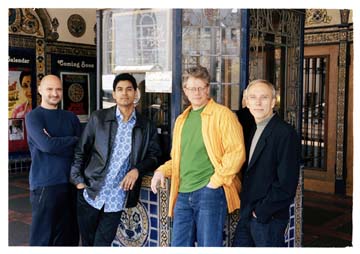
Theory is often a feature of experimental or avant-garde art; artists need to wrestle with what they feel is predictable in their art, and to undermine and recreate that art to better fit their vision of the world. But it often seems as if theory undermines the pure emotional enjoyment of art. When that happens the art form dries out and becomes meaningful only to a select set of practitioners. Contemporary music seems especially vulnerable to this irrelevance of the avant-garde.
Not so the art of the Kronos Quartet, which firmly aligns itself with experimental and avant-garde music and has done so for over 30 years, commissioning over 650 new works from radical composers scattered all over the globe, creating startling and innovative fusions between contemporary and traditional practitioners. This past week during their four-day concert series at Z Space @ Artaud, the ensemble that has rewritten the repertoire for string quartet showed why they have been able to endure and succeed at what they do. Their music, no matter how exotically conceived or theoretically explained, is always pleasurable and always a joy to listen to—emotionally as well as intellectually.
The central piece of the concert series was Australian composer Jon Rose’s Music from 4 Fences. For over 20 years Rose has been playing the many fences that cross the wide expanse of his country, bowing the wire and barbed wire strung from post to post. Rose writes, “I saw fences purely in terms of sonic material. However, the metaphorical significance of fence music soon became evident … Fence music often encapsulated the vastness of border country; it is the music of distance.”
Using metal frames some 6 feet high and 9 feet wide, the composer strung barbed wire and wire of different thickness and tautness to create fence instruments for the Kronos quartet. The frames were amplified, and, using double bass bows, the quartet stroked and banged on the wires. The result was like a great beast breathing—mythic and resonant.
The infinite reach of the lyrical
Terry Riley, a long-time collaborator with the group, also provided a new piece, which was performed all four nights, The Welcoming Baptism of Sweet Daisy Grace, in its San Francisco premiere. A contemplative piece, filled with bluesy and jazzy riffs and delicate phrasings layered over a drone of Indian music, The Baptism was dedicated to Riley’s new granddaughter.
Besides the Rose and Riley pieces, the quartet performed a different program each night of the four-day schedule. The shifting program of shorter pieces included work from different, established avant-garde composers and several shorter pieces by composers who are part of Kronos’ Under 30 Project, in which young composers under 30 are selected to write commissioned pieces for the quartet.
On Thursday evening, the quartet performed six selections from John Zorn’s The Dead Man. Wild man musician Zorn has written for almost every musical genre possible and on almost every instrument possible. In these short, gestural pieces he wrings as many kinds of creaking sounds as possible from the instruments, starting with the violist twisting his bow across his instrument’s strings in a series of squawking, screeching sounds, not unlike the cries you might imagine a body would make in a physical and violent struggle with death. As morbid as that may sound, the result is darkly comic in its absurdist howlings.
In contrast was Bloodstone by Amon Tobin, the young Brazilian-born electronic musician. Arranged by Stephen Prutsman and Michael Winger, this version of Bloodstone starts out like a Romantic quartet, the quartet playing in sync and in harmony, effusive and lyrical, sweet and melodic. The tempo and dynamics increase; sound falls from the strings like a long waterfall cascading to disappear into an oceanic depth in this powerful and poetic piece.
From the Under 30 composers came Felipe Pérez Santiago’s Campo Santo, with its strange wind-like sounds and layers of recorded percussive sounds and voices blending to create the sense of vast, open space that is both lyrical and panoramic.
—Jaime Robles
Originally published in the Piedmont Post.
Photo by Jake Blakesberg
